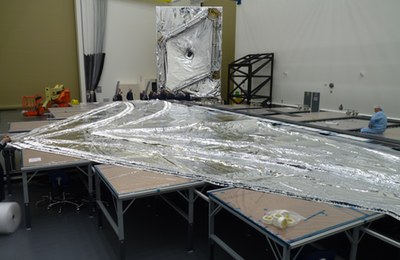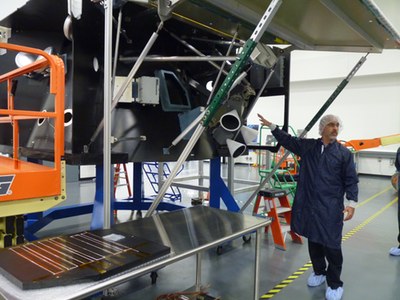A space telescope stays the courseby Jeff Foust
|
| “The budget that we’re working to is the replan budget that was established back in 2011. We are working to that budget and schedule,” said Eric Smith, JWST deputy program manager. |
That led to a “replan” for the JWST program, setting a new budget of $8 billion through launch in late 2018. More than a year after that replan, the message from NASA and key contractors is that the giant space telescope is back on track, sticking to its budget and schedule, even as budgetary uncertainties, some beyond the control of the program, remain.
“The budget that we’re working to is the replan budget that was established back in 2011. We are working to that budget and schedule,” said Eric Smith, deputy program manager for JWST at NASA Headquarters, in a JWST “town hall” meeting at the 221st meeting of the American Astronomical Society earlier this month in Long Beach, California. “That was news 18 to 24 months ago, but today those things are the same.”
Later in his presentation, Smith noted JWST completed 34 of 37 planned milestones in fiscal year 2012, 16 of which were finished ahead of schedule. The other three milestones, including the delivery of two of JWST’s instruments, have been delayed to FY2013, but won’t affect the overall program. “We’ve been able to cover that with existing budget reserves and schedule reserves. There is no change to the launch date and no change to the budget,” he said.
That performance to cost and schedule was emphasized two days later at a tour of Northrop Grumman’s facilities in Redondo Beach, California, where elements of the space telescope are being built. Scott Willoughby, Northrop Grumman vice president and JWST program manager, noted the company had just achieved its fifth milestone of the fiscal year, testing of the aft optics system of the telescope.
“This is a fun state of the program,” Willoughby said. “We’re really moving into production.”
During a tour, the company showed off some of that work, currently in the form of engineering units designed to test key elements of the overall spacecraft. That included three full-sized “flight like” sunshields, make of Kapton, with two more under development. Those will be used to test how to stow them for launch and then deploy them once in space, shielding the telescope and instruments from solar radiation and thus keeping them at operating temperatures of under 50 kelvins. Also on display was a one-third-scale of the sunshade, used to test thermal models.
The sunshade work is one part of a wide ranging effort over the next several years to test the various components of the overall observatory, integrate them, and perform more tests to make sure the systems are working as planned, something particularly vital for a spacecraft as complex as JWST and one that, unlike Hubble, is not designed to be serviced.
 Layers of Kapton that are part of a full-scale engineering test article of JWST’s sunshield lay on a table in a Northrop Grumman clean room, while standing in the back is one-third-scale model of the sunshield used for thermal tests. (credit: J. Foust) |
All of the integration and test (I&T) efforts are designed to minimize the risk of major issues with the telescope, “trying to catch problems at the lowest level possible when they’re easiest to fix,” said Randy Kimble, JWST I&T project scientist at NASA Goddard, at the JWST town hall meeting. That includes various types of cross-checking and independent testing to confirm that the various components are indeed working as planned. “In the optical context you can think of this as avoiding the Hubble primary mirror problem.”
That extensive testing process features a series of tests of the Integrated Science Instrument Module (ISIM), which will contain the observatory’s four science instrments, in a thermal vacuum chamber at Goddard starting later this year. At the same time, the project is renovating a much larger Apollo-era chamber at the Johnson Space Center for later tests of the ISIM after it is integrated with the telescope optics.
| My priority, and it is an agency priority, would be to try and protect the James Webb Space Telescope’s October 2018 launch,” Grunsfeld said. |
But while project officials make the argument that the telescope is back on track after previous cost and schedule overruns, not everyone is convinced. Rep. Dana Rohrabacher (R-CA), vice-chairman of the House Science Committee who participated in a policy forum at the AAS meeting, said afterwards he wasn’t yet convinced JWST was on track. “It was so out of whack that I’m not sure” it’s overcome those problems, he said. “We will hold hearings on that early on and we’ll find out.”
Another issue facing JWST is the uncertain state of the NASA budget and concerns of across-the-board budget cuts that NASA and other federal agencies could face if sequestration, originally set to take effect in January but since deferred to March, does take place. Sequestration would cut NASA’s science budget by over eight percent, but give the agency some leeway in determining how to allocate those cuts.
Some in NASA believe that, even with sequestration, JWST may avoid the brunt of any cuts given its position as an agency priority. When NASA and Congressional leaders jointly unveiled the design of the Space Launch System (SLS) in September 2011, they identified three priorities for the space agency: development of SLS and the Orion crewed spacecraft; utilization of the ISS, including development of commercial cargo and crew systems; and JWST. That, officials believe, could shield it from cuts created by sequestration.
“My interpretation of that is that even if we have sequestration, or flattening of the budget or reduction of the NASA bottom line, successfully executing JWST to its plan will remain a priority, which means JWST will not participate in the budget reduction,” said Paul Hertz, head of NASA’s astrophysics division, during a presentation to several program analysis groups chartered by NASA to provide community guidance to its astrophysics programs just before the AAS meeting.
John Grunsfeld, NASA associate administrator for science, offered similar guidance at a NASA town hall meeting during the AAS conference. “My priority, and it is an agency priority, would be to try and protect the James Webb Space Telescope’s October 2018 launch,” he said. He added that agency planning for sequestration had only just started before the January 1 deadline was pushed back, but that he and Hertz had emphasized to agency leadership that JWST should be protected “because we put an enormous amount of effort in getting that program on a very firm footing.”
If JWST is shielded from budget cuts, though, other science programs could suffer deeper cuts should sequestration, or similar across-the-board cuts, go into effect this year. That could generate a new round of debate about the program just as it shows progress in getting beyond its previous cost and schedule problems. JWST may not yet be done attracting attention beyond its technology and science potential.
